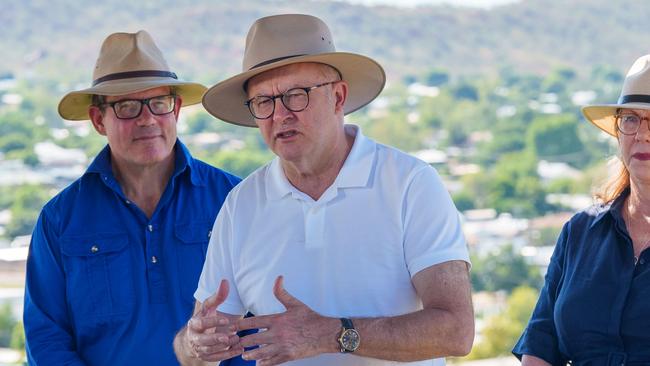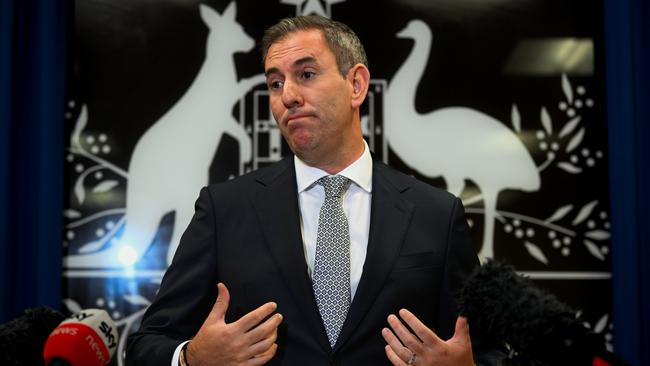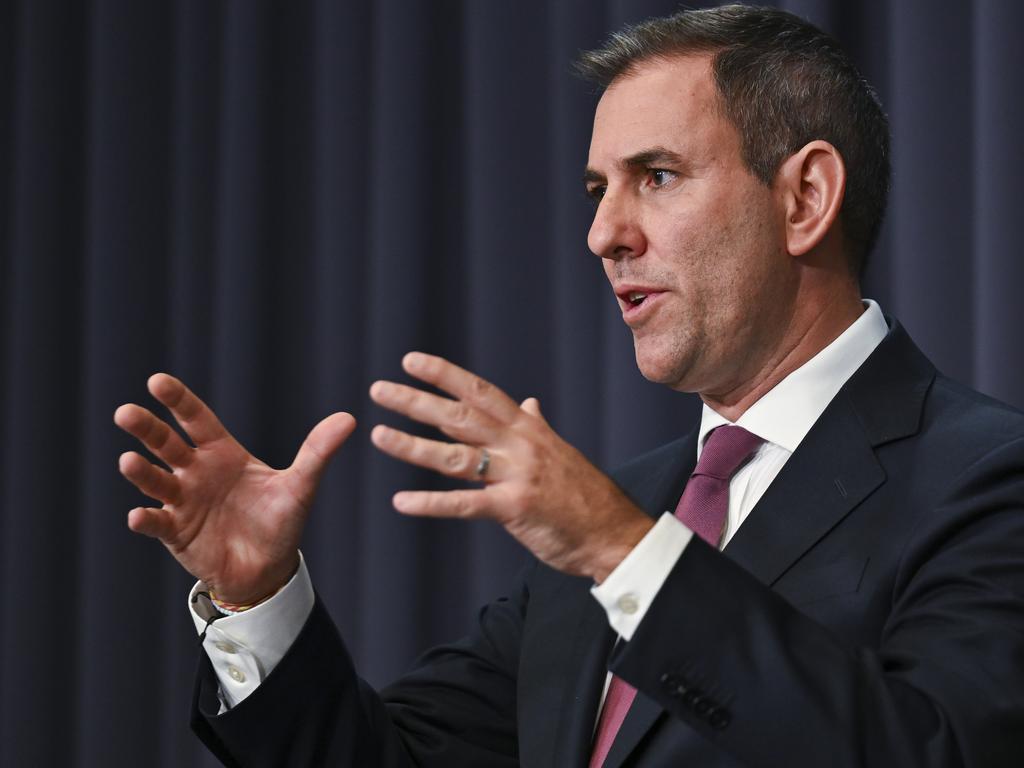Anthony Albanese passes buck on rates as chance of February relief firms
As investors moved to bolster their bets of a February rate cut, Anthony Albanese has given his most strident defence yet of the recent surge in government spending.

Anthony Albanese has given his most strident defence yet of the recent surge in government spending, rejecting claims Labor is undermining the Reserve Bank’s efforts to tame price pressures as investors moved to bolster their bets of a February interest rate cut.
The shift followed the release of consumer price index data on Wednesday showing the RBA’s preferred measure, trimmed mean inflation, edged lower to 3.2 per cent in the year to November, close to the central bank’s 2 to 3 per cent target band.
The annual headline inflation rate, which has been temporarily lowered by federal and state energy bill rebates, rebounded to 2.3 per cent, up from 2.1 per cent in the previous month, according to data from the Australian Bureau of Statistics.
Responding to the figures, traders moved to bolster their rate cut bets, ascribing a near 75 per cent chance of a quarter point reduction at the RBA’s February board meeting.
Money markets are fully priced for a cut at the board’s March meeting which would take the cash rate to 4.1 per cent.
Labor is holding out for interest rate cuts ahead of the federal election, which must be held on or before May 17, to improve its standing with cash-strapped household borrowers who have weathered 13 rate increases since May 2022, taking the cash rate to 4.35 per cent.
But on Wednesday, the Prime Minister rebuffed suggestions that he would bear the responsibility if household borrowers didn’t receive relief before the election, arguing it was the Reserve Bank that was responsible for setting interest rates.
“What I will take responsibility for is making sure that inflation, which had a 6 in front of it and was rising when we came to government, now has a 2 in front of it and is falling,” he told reporters in Mount Isa.
Mr Albanese also hit back at criticism from the Coalition and some economists that increased spending on the public service, infrastructure and the care economy was making the central bank’s job more difficult after the mid-year budget update in December revealed $19.1bn in new spending decisions.
“We have saved so much money on interest repayments and lowering debt as a result of the responsible fiscal position that we have taken, by making savings and by making sure as well that revenue upgrades overwhelmingly were put back to the bottom line,” he said.
Speaking at a separate press conference in Brisbane, Jim Chalmers declared the inflation figures were “very encouraging” but refused to be drawn on whether they should spur the RBA to cut rates in February.
“I don’t give free advice to the Reserve Bank,” the Treasurer told reporters, despite referring to the shift in market pricing on several occasions.

Dr Chalmers also referred to comments made by RBA governor Michele Bullock, who last month expressed her increasing optimism about the RBA’s efforts to cool price pressures amid signs of weaker wages and economic growth.
“Like the government, they’re not complacent about that, but they’re confident that we have seen and are seeing substantial and sustained progress in the fight against inflation,” he said.
But opposition Treasury spokesman Angus Taylor slammed Labor over its economic credentials, pointing to other central banks that have moved to cut interest rates at speed.
“We know there’s no light at the end of the tunnel any time soon,” he said. “We’re not seeing interest rate cuts that we’ve seen in the United States, Europe, the UK and Canada … because our inflation remains stubbornly high.”
Indeed, most economists are more sceptical about the possibility of a pre-poll cut and do not expect the RBA to begin cutting rates until its May 19-20 board meeting, days after the impending federal election must be held.
As November’s monthly data does not provide a full read of the entire basket of goods and services measured by the ABS, the December quarter inflation report, scheduled for release on January 29, will be closely scrutinised by the RBA in its decision next month.
RBC Capital Markets chief economist Su-Lin Ong said while the door was now open for a February rate cut, she expected a later start to the RBA’s easing cycle as additional public expenditure kept the central bank on the sidelines.
“We still think the RBA will err more cautiously given the still tight labour market, uncertainty around the timing of the Australian federal election and likely additional expenditure as well as the incoming US administration,” Ms Ong said, pencilling in a May rate cut.
The expectation for a later start to interest rate cuts was shared by Judo Bank’s Warren Hogan, who pointed to the acceleration in the headline inflation rate.
“These figures won’t make the RBA any happier about the trajectory for inflation,” Mr Hogan said, adding: “The economic case for a rate cut (in February) is not there.”
However, other observers, including Goldman Sachs chief economist Andrew Boak, said the figures confirmed inflation was continuing to recede. “Our conviction in a February rate cut continues to increase,” he said.
The monthly inflation figures showed a sharp reduction in electricity prices – owing to federal and state government energy bill rebates – which fell 21.5 per cent in the year to November, helping to hold the headline inflation rate within target.
Ms Bullock has repeatedly stressed, however, that the central bank will look through the headline measure, which has been distorted by the government support, with the RBA focused on underlying inflation which it expects will fall below 3 per cent by year’s end.
Of particular concern for the RBA, November’s report also revealed inflation in the labour-intensive services sector continued to rise strongly at an annual rate of 4.2 per cent, although it was down from 4.8 per cent in October.
Compared with 12 months earlier, rents were up 6.6 per cent.
Insurance and financial services costs increased by 5.5 per cent, while education fees climbed by 6.3 per cent.
Also acting as a potential barrier to rate cuts were signs of strength in the jobs market – which the RBA believes is beyond so-called “full employment” and adding to inflation – with separate data showing the number of job vacancies rose for the first time in almost two years.
“If the jobs market is tightening, this will make it even harder to achieve the ‘last mile’ of getting core inflation all the way sustainably back to target,” HSBC chief economist Paul Bloxham said.
Appearing on ABC News, Mr Albanese turned his attention to the legislation Labor will work to pass during parliament’s return for a fortnight in February.
“We want to get, firstly, our legislation for production tax credits through the Senate. It got carried as the last item of business in the House of Reps when we sat in December,” he said.
“We want to encourage that investment because we think that we need to seize the opportunities which are there.”
Should parliament reconvene it would be conditional on federal election timing, and would likely be the last sitting weeks of the term.
Mr Albanese ruled out progressing his party’s deal for Environmental Protection Australia.
“(The Greens were supportive but) only if they get what they want, and what we won’t do is compromise on the values that we’ve put forward,” he said.
“We had a very good last week of parliament and I’m confident that when we come back as well, for the sitting period that we have ahead of us, we will continue to pursue our agenda.”
The Albanese government’s electoral reform bill also faced an uncertain future. Labor has so far failed to negotiate the reform’s details with the Coalition. Should Labor secure victory through a minority government the bill would be unlikely to progress, given opposition to the bill on the crossbench.
“We have 25 votes out of 76 in the Senate (on the reform bill). There’s a range of legislation that we didn’t get through in the last sitting of parliament,” he said.





To join the conversation, please log in. Don't have an account? Register
Join the conversation, you are commenting as Logout